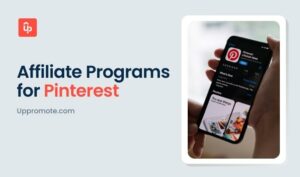Learning the essential steps to affiliate marketing success is vital to ensuring a more productive passive income stream. Although it takes perseverance and dedication, the procedure is a cinch.
How straightforward? Let’s just say following seven easy steps will have you earning your first affiliate paycheck within weeks. And if you commit more, there’s a good chance you don’t have to wait that long.
Does that sound great, or what?
Let’s start with the seven basic yet crucial steps to becoming a successful affiliate marketer.

7 Basic Steps to Affiliate Marketing Success
Some resources propose at least ten sequential steps to affiliate marketing success. We think ten is too much. So, we shortened the process a bit to make affiliate marketing more “feasible” and “less challenging,” especially for beginners.
- Step 1. Choose your niche.
- Step 2. Find affiliate programs to join.
- Step 3. Build a website or a blog.
- Step 4. Create solid content.
- Step 5. Direct traffic to your website/blog.
- Step 6. Place affiliate links.
- Step 7. Track your performance.
Step 1. Choose your niche.
All successful affiliate marketers start with a target niche! But what’s a niche?
A niche is a market segment you want to specialize (i.e., computers, fashion, baby care, etc.). It underscores your passions and interests (even hobbies), and allows you to create meaningful and relatable content.
You’ll want a niche you’re good at to be a successful affiliate marketer.
The idea behind considering your niche in affiliate business is to build credibility and trustworthiness among your audience or followers and platform.
Think about it. Would your followers trust you about a product you know nothing about?
Credibility matters, especially in affiliate marketing!
Succeeding steps hinge on this “market specialization.” Hence, you might want to give it a thorough thought.
Think about your interests, passions, skills, and hobbies. Everyone is “good” at something, so you might want to start with this.
Identifying a niche lets you create believable content. Followers and commissions will fall into their respective places. It should set you off on a clear path to affiliate marketing success.
Step 2. Find affiliate programs to join.
Looking for affiliate programs to join is the second most crucial step, and opportunities abound!
Did you know more than four out of five brands (yes, including big-time Fortune 500 companies!) have an affiliate marketing program?
With 334 million brands worldwide, that’s a staggering 270.5 million with an affiliate marketing tactic!
Joining a program or platform gives you access to products and services to generate income. These brands are your partners in building your future.
Here’s how to choose one.
- Google affiliate programs to join. Type “affiliate marketing (niche)” on the search bar, and you’re good to go.
For example, keying the phrase “affiliate marketing web hosting” returns nearly 550 million results. Now, pick the URLs on the first page and examine them further. You could also search the product instead of niche.

- Choose a reputable and trustworthy brand. Should you pick well-established big-name brands or lesser-known companies? How about both?
Analyze the company’s history and track record, including issues with the Better Business Bureau and similar organizations. You’ll also want to examine their quality products, systems, and processes. After all, you cannot (and should NOT) promote mediocre-quality offerings to your followers.
- Study the brand’s commission structure. Brands vary in commission models.
For example, some will pay a 5% to 30% commission rate for every verified sale (cost-per-sale or CPS), while others observe a cost-per-action (CPA) philosophy. Still, some brands will pay you for every lead (cost-per-lead or CPL).
- Determine cookie duration. “Cookies” are trackers, allowing the merchant to validate a user-initiated action and give commission to the correct affiliate marketer.
Here’s a tip! A cookie with a longer lifespan is BETTER! For instance, a 90-day cookie is more advantageous to affiliate marketers than a 24-hour version.
- Study the TaCs. Earning commissions is easy IF you follow the platform’s terms and conditions.
Sadly, many beginner affiliates forget this step. Affiliate fraud is a serious concern among businesses, costing them millions of dollars annually. Going against a program’s terms and conditions is a form of affiliate fraud.
- Choose a program. Should you pick a low-volume, high-paying program or a low-paying, high-volume one? Either program is excellent for beginners, although everything depends on whether you’re more confident promoting products with few buyers or products with mass appeal.
How about a high-volume, high-paying program? Sadly, we don’t recommend this for beginners, only for seasoned affiliates.
Picking the right program to join will set you up for affiliate success.
Step 3. Build a website or a blog.
Building a website or a blog is an essential requirement for any affiliate program, although some brands. After all, you need a platform for creating, developing, and sharing content for audiences to read.
Consider the website “your company” offering valuable information to “potential customers” and hoping they will click on the link that earns you a commission.
Here’s how.
Secure a domain name (a URL) and a web hosting service. Ideally, the domain name must reflect the niche, easy to type, and contain vital keywords. As for the web hosting platform, choose one with fast and secure services. And oh, affordable, too!
You can hire a website designer (or developer) or do-it-yourself. Thankfully, many web hosting services offer handy website builders, including themes, elements, pages, and what-have-yous.
Moreover, the Federal Trade Commission requires affiliate website owners to disclose the affiliate connection to ensure transparency.
Having an active blog or website with hundreds, if not thousands of daily visitors should make your affiliate marketing journey more productive.

Step 4. Create solid content.
What’s the point of building a website if you don’t have constantly engaging and meaningful affiliate content?
Think about it.
Readers are knowledgeable enough to differentiate a “made-up” story from an authentic, real life-based article. Readers (potential customers) are willing to try your “products” if they believe your post addresses some daily problems.
And that translates to more commissionable opportunities!
Creating solid content depends on your writing style and intent.
For example, buying and testing the product IS the most effective way to go if you’re into product reviews! You can describe the item’s physical properties and hidden functions more elaborately than the accompanying product manual.
And if you go the extra mile, you could describe ways the product can solve everyday problems. Your followers will believe you because you’re talking from “experience” and not just mental machinations.
Here’s another tip!
Supporting your claims with scientific evidence can boost the likelihood of followers and audiences respecting and believing your article. You could contact product experts and collaborate with them in validating your findings. Some might reject you outright, but some would be eager to share their “expert opinion.”
Need a concrete example? Try logging into Wirecutter’s website and check out their blogs and articles.
Solid content fosters trustworthiness and increases the likelihood of audiences clicking the commissionable link. So, make this step count.
Step 5. Direct traffic to your website/blog.
Creating content is one thing. Encouraging others to visit your blog or website is another. After all, what’s the use of having engaging content and high-quality products if nobody logs into your site?
This step boosts your chances of earning more. The more people visiting your blog, the more opportunities these audiences become your “customers.” And that translates to more commissions.
But how do you do it?
- Search Engine Optimization
SEO remains king in driving organic traffic to websites, blogs, and other “indexable” digital channels. This strategy requires an excellent command of keywords, keyword-related concepts, and page optimization techniques to rank high on Google and other leading search engines.
So, ensure Google can find your content from the millions of keyword-related URLs and index it high enough on SERPs for internet users to click. And that means staying abreast of Google’s algorithm updates.
- Pay-per-click
Although SEO-based traffic generation is “free,” it takes effort and time before you see results. Hence, paying for traffic to your affiliate website is a viable solution if you’re short on patience.
- Email List
Most affiliates offer an email course, a printable or downloadable app, or a free e-book to encourage audiences to subscribe.
Directing “traffic” to your blog is like having “barkers” outside the mall calling on people to shop. The more people entering, the higher your chances of getting a sizeable commission.
 Step 6. Place affiliate links.
Step 6. Place affiliate links.
Affiliate links are special codes! And they are your key to earning commissions. They are the “bridges” that connect audiences from your blog to the merchant’s website.
These links contain crucial information allowing the business to credit the commission to whoever drove the traffic. That’s more Benjamins for you.
So, how do you place links on your website?
Choose link placement wisely. It cannot be toward the page’s bottom because few people scroll all the way down. Links cannot cram every word in the article, lest you appear spammy.
Consider the article’s context and weave links naturally. Alternatively, well-meaning boxes, thoughtfully-developed tables, enticingly-creative buttons, and other “callouts” can attract audience attention.
Commissionable links are vital, allowing you to monetize your efforts.
Step 7. Track your performance.
Most affiliate networks and programs provide affiliates with a user dashboard to monitor their marketing campaigns. Affiliate performance tracking is crucial because you’ll want to know which digital marketing activities produce the intended results.
And which tactics don’t.
But what metrics should you focus on?
Over 80% of seasoned affiliates monitor the total number of clicks on affiliate marketing links, while seven of ten digital marketers focus on conversion rates. Not far behind at 62% are the total purchases attributable to commissionable links.
These three metrics are an affiliate’s “bread-and-butter,” allowing digital marketers to rethink their affiliate marketing strategies to boost income potential.
Equally important is affiliate performance tracking frequency. You can track your affiliate performance weekly to quarterly, or whichever is more convenient.
Tracking your affiliate marketing campaign and performance makes sense, motivating you to persevere.
How Does Affiliate Marketing Work?
Affiliate marketing works like any other business, generating sales from potential customers. However, it varies from the “traditional” marketing sense because you (the affiliate) don’t have “formal” ties with the merchant or business.
So, how does that actually work?
Suppose Company A has several product offerings. This business can hire a professional marketing agency and pay thousands of dollars monthly. Or, it can recruit and hire affiliates to promote the products for a commission.

Why would a company invest in affiliate marketing instead of the traditional route? Good question!
Billboard space, TV advertising, print media, and other conventional marketing campaigns ARE expensive! Meanwhile, digital marketing is cheaper, relying on affiliates’ existing internet presence to “spread the word.”
It’s like outsourcing to individual marketers, leveraging their reach to promote and sale products. For example, suppose you have a website with a million followers or subscribers. Writing about a company’s products or services in your blog exposes the brand to your audiences.
You’ll have links to the company’s website, allowing your audience to visit the brand after clicking a unique code. And when they do that, the link leaves a “cookie” for the merchant to track.
If the audience returns to the merchant’s website and clicks the BUY button, the “cookie” sends a “message” to the merchant. The company verifies the transaction and pays you a commission or fixed rate for driving a customer to them.
Hence, the company doesn’t pay for advertising, although it gives you marketing tools to mount an effective campaign. But these resources are a penny compared to big-budgeted marketing activities like TV ads, Super Bowl commercials, celebrity endorsers, and more.
It’s a win-win!
The company saves money on traditional marketing activities while you earn income from affiliate marketing.
Best Tips for Affiliate Marketing Success
The following tips will help ensure a steadier flow of passive income as an affiliate marketer.
Always think about your audience
Prioritizing your audience is a sure-hit affiliate marketing tip! And by “audience” we mean website visitors, social media followers, families, friends, neighbors, colleagues, and virtually anyone who deserves a high-quality product that addresses their “pain points.”
Successful affiliates have a clearly defined target audience! They are the people you promote to, allowing you to earn a commission if they buy through your affiliate link.
Focusing on their needs is essential. You can write relatable stories, introducing how a product helped you solve several issues.
Trustworthiness is key! Otherwise, your audience wouldn’t believe you nor the product you’re promoting. And that’s why putting audiences above commissions matters!

Grow and nurture your list of subscribers
How do you grow and nurture your subscriber base? With excellent, highly-engaging, highly relatable, and valuable content, of course!
Forbes identifies ten reasons why meaningful digital content matters, and the first one drives home the essence of affiliate marketing.
Trust!
Insightful, helpful, and meaningful content establishes and strengthens trust. And when your subscribers trust you, they’ll spread the word across various social networks. They become your ambassadors or goodwill spokespersons, allowing you to grow your subscribers even though you don’t know them personally.
You can read more: 17 Essential Tips For Common Affiliate Marketing Mistakes
Focus on quality leads instead of quantity
You can apply the Pareto Principle even with affiliate marketing. It underscores how 80% of your total commissions can potentially come from 20% of your leads!
Imagine you have 100 potential leads with a $10,000 plausible commission. Twenty clients will bring you $8,000 commission, while the remaining 80 “potential customers” will only generate $2,000.
The real question is identifying the 20% who will give you 80% in outcomes.
It’s never easy because leads (or potential customers) are individuals. You must focus more on the “quality of leads” than the number. But how?
You can analyze demographic data, business information, social media & email engagement, and user behaviors. You could also utilize a program to detect spam contacts, weeding them off your list.
Focus on conversion rates instead of commissions
As mentioned, audiences take utmost priority. Commissions follow when you care enough for and about your potential customers.
Prioritizing your audiences helps boost conversion rates (the percentage of visitors becoming leads or sales). Although the average affiliate is happy with 0.5 to 1.0 percent conversion, you can improve this by focusing more on your customers.
Track your effort on a regular basis
You can’t be a successful affiliate marketer if you cannot track your campaigns and performance.
Monitoring gives you a head’s up on the campaigns producing stellar returns, while giving you insight on poor-performing ones. You can either ditch the latter or improvise.

FAQs
What’s the cost to start with affiliate marketing?
Although most companies with affiliate programs are free to join, they require some essentials. Resource costs vary depending on your commitment to succeed as an affiliate marketer.
For example, owning a website requires hosting services for a fee. You’ll also need to test a traffic tier, which could set you back by about $300. Affiliate tracking tools can also cost you at least $100 monthly, while landing page builder, spy tools, creatives, and SEO resources could cost another $100 monthly.
A $500 budget should help you get off a good start as an affiliate marketer. The more advanced you progress, the more high-tech tools you’ll need. And that requires an even bigger budget.
How much can an affiliate marketer potentially earn?
The average beginner affiliate income is less than $1,000 monthly, while an intermediate-level affiliate can bring home at most $10,000.
Advanced affiliates can enjoy monetary compensation not exceeding $100,000 monthly, while super-affiliates are multi-millionaires bringing home over $1.2 million annually.
Can I make money in affiliate marketing without a website?
Yes, you can make money in affiliate marketing even without a website.
For example, you could leverage social media platforms in promoting affiliate products. Some platforms encourage aspiring affiliates to post on Facebook, Instagram, YouTube, WhatsApp, TikTok, and other social media channels.
Online communities (i.e., internet forums) are also excellent website alternatives. You could paste your unique identifier link in these platforms (ensuring it’s relevant to the thread) and be instrumental in helping other forum members.
Some merchants allow (and actually encourage) email marketing to promote their products. This tactic works if you have an extensive email contacts list.
Other brands might allow SMS marketing, encouraging you to include the link in the text messages you send to friends, neighbors, and other social contacts.
While these methods can generate income as an affiliate marketer, they might not be as “productive” as using a website. On the bright side, they’re inexpensive!
Is it possible to combine affiliate marketing with other marketing strategies?
Yes, you can combine affiliate marketing with other marketing efforts.
For example, you can integrate search engine optimization (SEO) marketing strategies with affiliate marketing, add email marketing elements, or embed social media marketing tactics.
Influencer marketing and content marketing can also boost affiliate marketing campaigns, increasing your income-generating potential multi-fold.

Conclusion
Mastering the seven steps to affiliate marketing success is a breeze that even kids with sufficient tech-know-how can execute an effective digital marketing campaign. While affiliate marketing can be an excellent source of future wealth, please recognize the value of effort, commitment, and dedication in guaranteeing success.
Super affiliates didn’t become uber rich overnight. They toiled and persevered, recognizing adversities as challenges to a brighter future.
You could be as successful as these multimillionaires if you heed our simple advice. Focus on your audience, pick the right program, and build credibility and trustworthiness. You’ll get there.
Eventually.


 Step 6. Place affiliate links.
Step 6. Place affiliate links.




